In this in-depth article, we delve into the enchanting realm of Japanese style tattoos. From their historical origins to the modern-day revival, we explore the profound cultural significance and exquisite artistry that define this traditional form of body art. Join us as we uncover the intricacies and beauty of Japanese tattoos, while shining a spotlight on the renowned artists at Chronic Ink Tattoo who specialize in this captivating style.
The History of Traditional Japanese Tattooing
Also known as traditional irezumi, the original style of Japanese tattoo art is incredibly ancient and varied, probably more so than any other culture in the world. Due to its unique properties, people across the globe appreciate and design their own irezumi, sometimes with a personal flair that helps to move the style forward. Japanese traditional sleeves are very common and attract clients worldwide!
How Irezumi is Done
A Japanese tattoo artist, known as a Horishi, does irezumi by hand, using wooden handles and a metal needle that is attached to a silk thread. Special ink is required for this process, and is known as Nara ink, or zumi. The needles are incredibly painful and the process of getting this traditional tattoo done is time consuming. Because of this, many individuals view all-over body tattoos as a sign of strength and perseverance, and it requires literal hours and sometimes days to complete using the process of irezumi. Not only time consuming, irezumi also takes years of practice and decades to master. Horishi undertake apprentices that work for any number of years just trying to get the process right.
Taboo Tattoos
Once a symbol of the dashing and brave warriors of ancient Japan, the Meiji period brought new regulations and cultural taboos against irezumi, even going as far as to outlaw it completely. Thus, the only people who were still getting tattooed in this style were seen as criminals. A modern result of this is the fact that new yakuza, or Japanese gangsters, are avoiding this negative connotation with tattoos. However, there is still a subset of traditional Japanese underground yakuza who view the full body tattoo as not only an art form, but as one of the higher social statuses.
Asiatic Tattoo Styles
Aside from Japan’s long history of traditional tattooing, there is more contemporary but still classic style that most people are familiar with. Classic American tattoo styles derive from the Japanese design, such as bright colors, ocean elements such as koi fish and symbols of courage and protection. Watercolors and pastel shades also make for a well-recognized tattoo design. We can see especially emblematic tradition in the depiction of cherry blossoms, Japan’s national flower and a symbol of the festival celebrated every year since ancient times. The long standing traditions of Japanese culture as well as contemporary takes on design are well evident in the style and artistry of Asiatic tattooing.
The Ever Vigilant Fu Dog
In many Asian cultures, primarily China and Japan, the fu dog {or foo dog in Chinese} are representative as symbols of power, courage, and protection. You may have seen a few of these at Chinese or Japanese restaurants in the west. They are used to guard the establishment from evil spirits, traditionally in the home or elsewhere. Also known as lion dogs, these creatures look mean and tough, but they are friendly guardians to their masters. Often shown in male and female pairs to balance yin and yang, the fu dog is an incredibly popular design aspect for Japanese tattooing. The personality of the fu dog is also important in its style element, with traits such as perseverance, honesty, and patience, along with duty and loyalty to the family and master. Many people choose the symbolic fu dog as a representation of their own personality traits.
Woodblock Print
During the 18th and 19th centuries, there were many depictions of woodblock prints of animals, scenery, or important individuals with the capital to commission an artist to create a representation of them. Due to the need to have a skilled artist, there are very few historical depictions of men and women in woodblock printing. Often representative of the society the artist lived in, historic prints often showcase scenes of public figures or architectural structures that have an aesthetically pleasing quality.Japanese Society
Artists began creating permanent body art as far back as the Paleolithic era, or somewhere around 10,000 years ago. We can see evidence of this in line-like patterns on the faces and bodies of figures represented during that period. Tattoos were placed on criminals as punishment to showcase their criminality to the world in around 300-600AD. During this time and before, the indigenous Ainu people were known to have used tattoos as a form of decorative pieces and social status, which is typical of cultures across the world. Despite this, the Ainu were not known to have invented the general aspect of irezumi, though they did develop the same aspects of aesthetic value and craftsmanship seen in other areas of Japan.
Modern Japanese Tattoos
Japanese and Chinese language tattoos have always been popular due to the aesthetic of their calligraphy in general. It will be incredibly easy to find a tattoo and tattoo shop that will have legions of experience in the art of Japanese design. In Japan itself, there is an interesting relationship between the general public and the demographic of individuals who still design and appreciate the aesthetic culture of traditional Japanese tattoos. It may actually be difficult to find a regular tattoo shop in Japan due to the general cultural mistrust of the medium, but tourists will find them in heavily trafficked areas that cater to the out-of-towners. Due to the inherent association with tattoos and the yakuza, many Japanese businesses refuse entry or business to people with visible or otherwise unsightly tattoos. It’s an interesting dichotomy to see the reverence that traditional Japanese artists give to the art and tradition of tattooing, but also the negative associations with the history of criminality and lavish wealth displays.
Getting a Japanese Tattoo
Be sure to look at the portfolio of the potential artist you want doing your tattoo, as certain aesthetic styles like Japanese will take more time to learn and master. If you’re traveling, you may be able to find one of the only 300 tattoo shops located in the country, with higher prices that you may expect to pay elsewhere, but the level of quality and condition that you can trust coming from an experienced traditional artist. Once you’ve found someone will the skills to appreciate and design your tattoo, you’ll be able to adequately represent one of the world’s greatest and oldest permanent art styles.
Ready to Explore Your Own Japanese style Tattoo?
At Chronic Ink Tattoo, our talented artists are ready to help you explore Japanese style and other tattoos to make sure you find something you’ll want to show off for decades to come. If you’re in the Toronto, Markham, Mississauga, Kitsilano Vancouver area drop by our shop and check us out for yourself.
Tell us Your Idea

